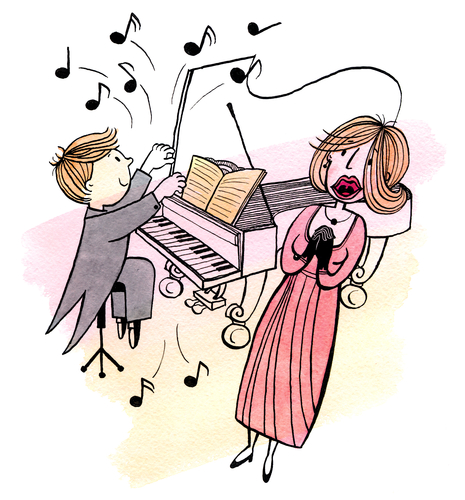It’s sometimes a little tricky to identify exactly what we need to practice on piano. I’m thinking about those times when “you’re up against a wall,” so to speak. You’re not “getting” something musically, or you see a gap in your piano playing but you don’t know how to fix it. What do you do?
This is the kind of thing they usually don’t teach you in music schools, at least not as part of the curriculum. Because both the problem and solution are individual to you at this point in time. Furthermore, we’re speaking about something very subtle and the answer is to be found in the particular you think.
For example, a young pianist asked me yesterday about a problem she’s been having when accompanying a particular singer (while performing classical music). She can play the piano part well by itself, but something doesn’t “click” when she accompanies the vocalist. They’re not together. Now, of course, there’s always the possibility that the vocalist is inexperienced and doesn’t sing in rhythm. But the pianist feels that maybe she could do more to keep things together during the performance.
Either way, it comes down to one thing: listening.
To accompany well, you need to become a better listener, while you’re playing. This is the tricky part. And by “listening,” I mean listening to everything.
Listening to the vocalist. Listening to the notes you play on piano. Listening to the flow of the music. Listening to the slight rhythmic fluctuations in each phrase. Listening to the dynamics. Listening to where the music wants to go, and knowing when to go with it and when to reign things in. Listening to the emotional content of the music. Listening to the emotional content of each players’ sound, and how these relate to and interact with each other. Listening to the nonmusical cues that musicians give each other.
Now, how exactly do you go about developing your listening ability? (I’m glad you asked!) Simple, but not obvious: You can practice this. Yes, practice “listening,” as a skill unto itself, separate from any rehearsal or performance situation.
You’ll need a friend to practice with you. For the pianist’s situation above, I would find a classical singer friend and explain that you want to work on your listening skills. Believe me, any vocalist will jump at the chance to practice with a piano accompanist! Go to a piano, and start making music together. BUT, and this is a big one, you need to agree that the listening is more important than how the music sounds (for this practice session, not forever). This is because you’re trying something that you’ve perhaps never tried before, at least maybe not to this degree.
Let’s say that you’re listing to the vocalist more than you’re own piano part. Well, at first this may cause you to play some wrong notes. For this practice session, this is OK. After all, you’re intentionally focusing on the singer, not the piano. Don’t worry about this. Go with it for not. Later on you’ll be able to listen to the singer and play the correct piano notes. But for an hour, focus on listening to the singer, or any of the other points I mentioned above.
At first this “global” type of listening may seem a little overwhelming. However, if you practice it for its own sake, as I’ve described above, it will eventually come naturally and you’ll find yourself always listening in this way.
There are a lot of good pianists in the world, but only a small percentage of them are good accompanists. Become a good accompanist, and you’ll always have someone who wants to make music with you. Have fun!
If you found my advice helpful, here’s where I learned to practice like this.
Take your left hand playing to a new level with my free ebook: Left Hand Techniques for Jazz Piano
You’ll also get my weekly jazz newsletter with practice tips and inspiration

